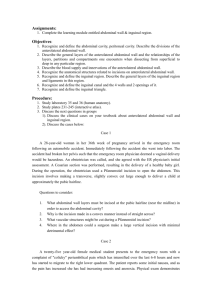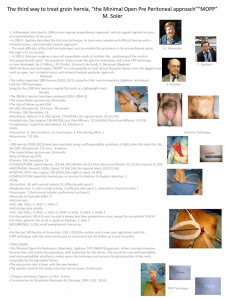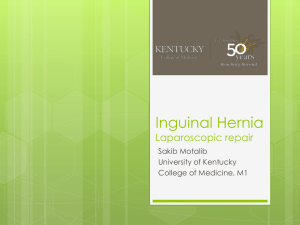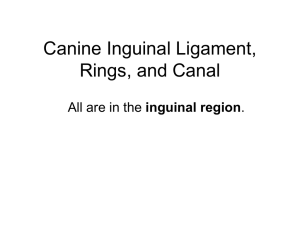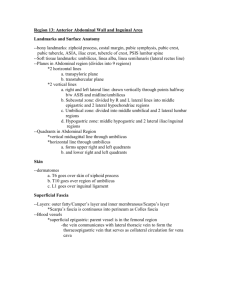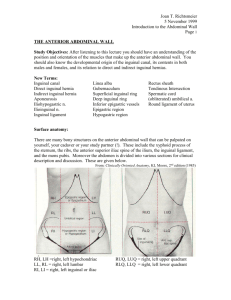MUSCULI THORACIS
advertisement
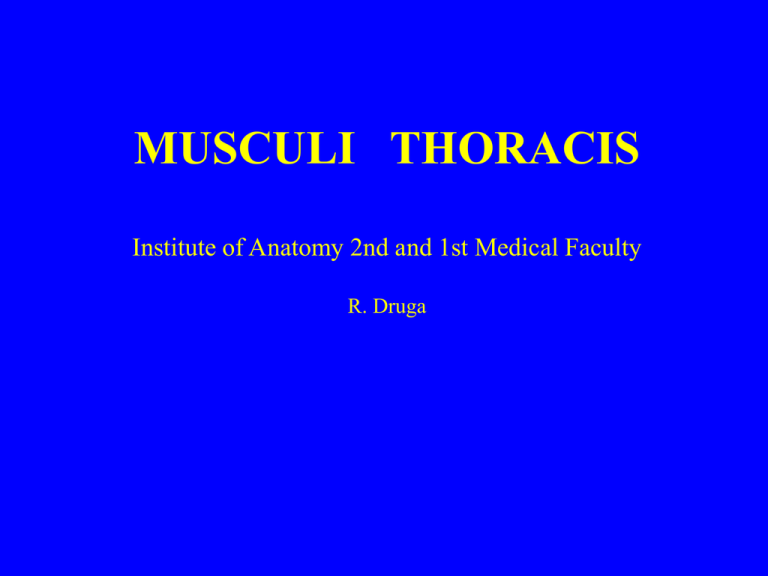
MUSCULI THORACIS Institute of Anatomy 2nd and 1st Medical Faculty R. Druga The muscles of the thorax • They are all concerned in the movements of the ribs and hence with respiration • The intercostales • Transversus thoracis • Levatores costarum • Pectorales Mm. pectorales M. Pectoralis major Origo : Sulcus deltoideopectoralis Clavicula, sternum Vagina m. rectorum Clavipectoral triangle Trigonum clavipectorale Anterior wall of the axilla Insertio : crista tuberculi majoris Clavipectoral fascia Relations of the pectoralis minor to axillary vessels and brachial plexus CLAVIPECTORAL FASCIA M. serratus ant. Origo : 1. – 9. Rib Insertio : medial margin of the scapula. N. Thoracicus longus Mm. Intercostales interni (11) Internal intercostal membrane (depression of the ribs) Exspiratory muscles From posterior costal angles to the sternum Mm.intercostales externi (11) Inspiratory muscles (elevation of ribs) From the tubercles of the ribs to the cartilage of the ribs in front Mm. Intercostales externi External intercostal membrane Spatium intercostale Intercostal space and layers of thoracic wall The intercostales intimi Poorly developed in upper spaces, More extensive in lower spaces Separate intyercostal vessels and nerve from the pleura Action : like the intercostales interni Spatium intercostale Puncture of the pleural cavity Punkce cavum pleurae DIAPHRAGMA THE DIAPHRAGM A dome- shaped muscle which separates the thoracic from the abdominal cavity. Its periphery consists of muscular fibres attached to the central tendon (aponeurotic). LUMBAR PART COSTAL PART STERNAL PART The diaphragmatic aperturtes : Aortic Oesophageal Vena caval Main inspiratory muscle DIAPHRAGMA • Hranice mezi dutinou hrudní a břišní Diaphragma Crus mediale L1 – L3 Crus laterale L 1 – L2 Lumbocostal arches Medial and lateral N. Phrenicus (C 4) Inferior phrenic artery Phrenic nerve Diaphragmatic part of the pericard Relations of the diaphragm • The upper surface is in relation with the pleura (right and left diaphragmatic pleura) and with the pericardium • Lower surface is covered by peritoneum Right dome Left dome 4th intercostal space 5th intercostal space Upper surface and diaphragmatic apertures Diaphragma - actions • Principal muscle of inspiration • During inspiration muscular fibres contract and the central tendon and domes move downwards (volume of the thoracic cavity increases) Inspiration • Elevation of ribs (external intercostal muscles) • Depression of the diaphragm • In quiet inspiration the principal muscle is the diaphragm • In forced inspiration additional muscles are called into action (pectoral, scalenic) Expiration • Relaxation of the diaphragm • Contraction of the intercostales interni MUSCULI ABDOMINIS Institute of Anatomy 2nd and 1st Medical Faculty M. Obliquus ext. 5th – 12th rib (8 slips) Vagina m. rectus abd. Linea alba Inguinal lig. Inguinal ligament M. Obliquus internus Iliac crest, lumbodorsal fascia 9th –12th rib Linea alba, vagina m. rectus abd. M. Rectus abd. ribs, pubis M. Transversus abd. 7th – 12th rib, iliac crest, inguinal lig. Linea alba, vagina mm. rectorum Vagina of the rectus muscles Vasa epigastrica inf. M. cremaster INGUINAL CANAL CANALIS INGUINALIS Lentgh 4 – 5 cm, from anulus inguinalis profundus (deep inguinal ring, entrance) to anulus inguinalis superficialis (superficial inguinal ring, exit) 4 walls Contens : funiculus spermaticus (spermatic cord, lig. teres uteri) Presence of canal appear to weaken the anterior abdominal wall Canalis inguinalis • Délka 4 – 5 cm • Anulus inguinalis profundus – anulus inguinalis superficialis • 4 stěny • Obsah – funiculus spermaticus, lig. teres uteri • Zeslabené místo přední stěny břišní • Hernie !!! Walls of the inguinal canal • Anterior wall –aponeurosis of the External oblique (superficial ring) • Posterior wall – transversal fascia (deep ring) • Lower wall – inguinal ligament • Upper wall - Internal oblique and Transversal (lower margins) Stěny canalis inguinalis • • • • Přední stěna : aponeurosa m. obliquus externus Zadní stěna : fascia transversalis Dolní stěna : ligamentum inguinale Horní stěna : m. obliquus internus a m. transversus abdominis Anterior wall Canalis inguinalis (superficial ring) Inguinal canal Posterior wall Falx inguinalis Interfoveolar lig. Inguinal triangle Posterior wall from behind Inguinal canal- sagittal section Cremaster muscle Posterior wall of the inguinal canal = transversal fascia Falx inguinalis, lig. interfoveolare Posterior wall of the inguinal canal – ligamentous bands • Falx inguinalis (inguinal falx, the conjoint tendon) – is formed by the lower part of the aponeurosis of the transversus and is inserted medially to the pubis • Interfoveolar ligament – laterally to falx, from lower margin of the transversus to pubis. Covers inferior epigastric vessels. Laterally to interfoveolar ligament is deep inguinal ring. • Between falx and interfoveolar ligament – inguinal triangle Peritoneal folds Peritoneální řasy a jamky Hernial sac Indirect hernia Kýlní vak, Hernia indirecta Inguinal hernia I (indirect, oblique) • The viscus is protruded through the inguinal region (canal) • Indirect (oblique) hernia – intestine is protruded inside of peritoneal sac - through • the lateral inguinal fossa (peritoneum) • Enters the inguinal canal at the deep inguinal ring • Pass along the inguinal canal • Enters the superficial inguinal ring • Lastly descends into the scrotum • Very frequently acquired variety, less frequently congenital Inguinal hernia II (direct) • • • • • • • Protrusion makes its way through – Medial inguinal fossa (peritoneum) Inguinal triangle Superficial inguinal ring (exit of the hernia) Is much less frequent than oblique hernia Occurs more often in men than in women Is always of acquired variety Hernia inguinalis, Tříselná kýla Vychlípený peritoneální vak Uvnitř vaku je kýlní obsah (klička střevní, omentum, močový měchýř) Vak prochází (protlačuje se) zeslabenými místy stěny břišní (může dojít k ruptuře transversální fascie) Herniae inguinales Hernia ing. directa : Vnitřní branka – trig. inguinale Zevní branka – anulus ing. superf. Získaná hernie Hernia ing. indirecta : Vnitřní branka – anulus ing. profundus Zevní branka – anulus ing. Superficialis Většinou získaná, vzácně vrozená hernie
